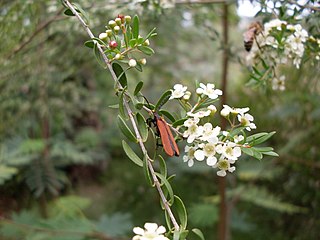
Baeckea is a genus of flowering plants in the myrtle family, Myrtaceae, all but one endemic to Australia. Plants in the genus Baeckea are shrubs or small trees with leaves arranged in opposite pairs, white to deep pink flowers with five sepals and five petals, and five to fifteen stamens that are shorter than the petals.

Melaleuca thymifolia, commonly known as thyme honey-myrtle, is a plant in the myrtle family Myrtaceae and is native to eastern Australia. It is often noticed in spring, with its attractive, purple flowers and is one of the most commonly cultivated melaleucas. A fragrant shrub, it usually grows to about 1.0 m (3 ft) tall, has corky bark and slender, wiry stems.

Boronia fraseri, commonly known as Fraser's boronia, is a plant in the citrus family occurring near Sydney in Australia. It is an erect, multi-branched shrub with pinnate leaves and pink flowers arranged in small groups in the leaf axils.

Thryptomene calycina, commonly known as Grampians thryptomene, is a species of flowering plant in the family Myrtaceae and is endemic to Victoria in Australia. It is an erect or spreading shrub with oblong, elliptic or egg-shaped leaves with the narrower end toward the base, and white flowers with five stamens.

Bossiaea rhombifolia, is a species of flowering plant in the family Fabaceae and is endemic to eastern Australia. It is an erect, glabrous shrub with diamond-shaped, more or less round or broadly egg-shaped leaves, and yellow and red or pinkish flowers.

Sannantha pluriflora, commonly known as tall baeckea, is a flowering shrub or small tree species in the myrtle family, Myrtaceae. It is endemic to Australia. Plants grow to 4 metres high. White flowers appear in groups of three to seven between October and April in the species' native range. These have five rounded petals surrounding 8–15 stamens. The fruits are 2.5 to 3.5 mm in diameter.

Rinzia orientalis, commonly known as desert heath-myrtle, is a species of flowering plant in the family Myrtaceae and is endemic to south-eastern Australia. It is a shrub with elliptic to narrowly oblong leaves and white or pale pink flowers usually with ten stamens.
Thryptomene caduca is a species of flowering plant in the family Myrtaceae and is endemic to a small area in the north-west of Western Australia. It is a spreading shrub with crowded egg-shaped leaves with the narrower end towards the base, and pink flowers with five petals and seven to nine stamens.
Thryptomene podantha is a species of flowering plant in the family Myrtaceae and is endemic to the west of Western Australia. It is a shrub with egg-shaped leaves with the narrower end towards the base, and flowers with pink sepals and petals and ten stamens.

Baeckea linifolia (swamp baeckea, or weeping baeckea is a heathland shrub found in three Australian mainland states: New South Wales, Queensland and Victoria, where it is rare. It grows up to 1.5 metre high,. It grows in heath in damp places, often near waterfalls and gullies, along the coast and adjacent ranges.

Boronia granitica, commonly known as granite boronia, is a plant in the citrus family, Rutaceae and is endemic to a small area of eastern Australia. It is an erect shrub with many branches, compound leaves and pink, four-petalled flowers.

Philotheca brucei is a species of flowering plant in the family Rutaceae and is endemic to Western Australia. It is a shrub with cylindrical leaves grooved along the top and in spring, white to pink or mauve flowers with five egg-shaped petals.

Hibbertia bracteata is a species of flowering plant, in the family Dilleniaceae, and is endemic to eastern New South Wales. It is a shrub with lance-shaped to oblong leaves and yellow flowers with about sixteen stamens arranged on one side of the two carpels.

Leptospermum parvifolium, commonly known as lemon-scented tea-tree, is a species of shrub that is endemic to eastern Australia. It has thin, rough bark, egg-shaped leaves with the narrower end towards the base, white or pink flowers, and fruit with the remains of the sepals attached but that is shed when the seeds are mature.

Leptospermum divaricatum is a species of plant that is endemic to inland New South Wales. It is an erect or weeping shrub with compact fibrous bark, elliptical to egg-shaped leaves, white flowers arranged singly on short axillary side shoots and woody fruit that fall off when mature.
Triplarina calophylla is a species of flowering plant in the myrtle family, Myrtaceae and is endemic to a restricted area of north Queensland. It is a shrub with egg-shaped leaves with the narrower end towards the base, flowers with five sepals, five white petals and fourteen or fifteen stamens.

Triplarina imbricata, commonly known as creek triplarina, is a species of flowering plant in the myrtle family, Myrtaceae and is endemic to northern New South Wales. It is a shrub with weeping branches, narrow egg-shaped leaves, and flowers in pairs with five sepals, five relatively small white petals and fourteen to seventeen stamens.

Triplarina volcanica is a species of flowering plant in the myrtle family, Myrtaceae and is endemic to Queensland, where it is only found in three mountainous areas. It is a shrub with elliptical to egg-shaped leaves with the narrower end towards the base and flowers with five sepals, five white petals and fourteen to sixteen stamens.

Baeckea omissa is a species of flowering plant in the family Myrtaceae and is endemic to eastern Australia. It is a shrub with egg-shaped to lance-shaped leaves with the narrower end towards the base and white flowers mostly with ten to fifteen stamens.

Baeckea diosmifolia, commonly known as fringed baeckea, is a species of flowering plant in the family Myrtaceae and is endemic to eastern Australia. It is a shrub with lance-shaped leaves with the narrower end towards the base, and white flowers with seven to nine stamens.
















